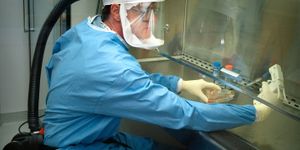Skin Deep: Handheld Device Sees the Earliest Signs of Cancer
Researchers have developed a handheld device that can image structures under the skin at resolutions 100 times greater than that of X-Rays, computed tomography (CT) and Magnetic Resonance Imaging (MRI).
The device was designed to be portable and easy to use, allowing healthcare personnel to image internal organs directly at a clinic or the patient’s bedside — avoiding the long waits and costs of specialized diagnostic facilities.
This new imaging technology is so sensitive that it can detect some of the earliest cellular abnormalities linked to cancer. This is particularly important for spotting tumors originating in the epithelium, a thin layer of tissue lining organs such as the colon, stomach and skin. Current imaging technologies often fall short when it comes to imaging epithelial tissues as they are unable to reach tissue depths of even a single millimetre.
Known as micro optical coherence tomography, or OCT, this new device relies on the near-infrared spectrum of light that penetrates the human body harmlessly. The device accurately measures the time taken for the emitted light to return after bouncing off internal tissues, allowing it to construct an image of the 3-dimensional structures below the skin.
Six years in the making, this research was the fruit of a collaborative effort between imaging scientists at Nanyang Technological University, Singapore, Harvard Medical School and the University of Alabama.
Lead researcher, Professor Liu Linbo, said, “Our device is a fraction of the size of existing machines and produces clear, high-resolution images in real-time. It uses light to harmlessly penetrate the skin, and it does not involve specialised lead-shielded X-ray equipment or MRI scanners. It is small enough to be handheld, so images could be captured by the bedside.”
A prototype of the device was trialled at the Renmin Hospital of Wuhan University to validate its use in detecting colon polyps — small clumps of cells that form in the lining of the colon or rectum which can progress into cancer. Colonoscopies are the most sensitive test for colorectal polyps, but are invasive and have to be done under sedation.
When put to the test, the device was able to assess whether polyps were malignant or benign with 95 percent accuracy. Commercialization of this technology could pick up cancerous changes much earlier, vastly improving patient outcomes.
Source: Nanyang Technological University.









